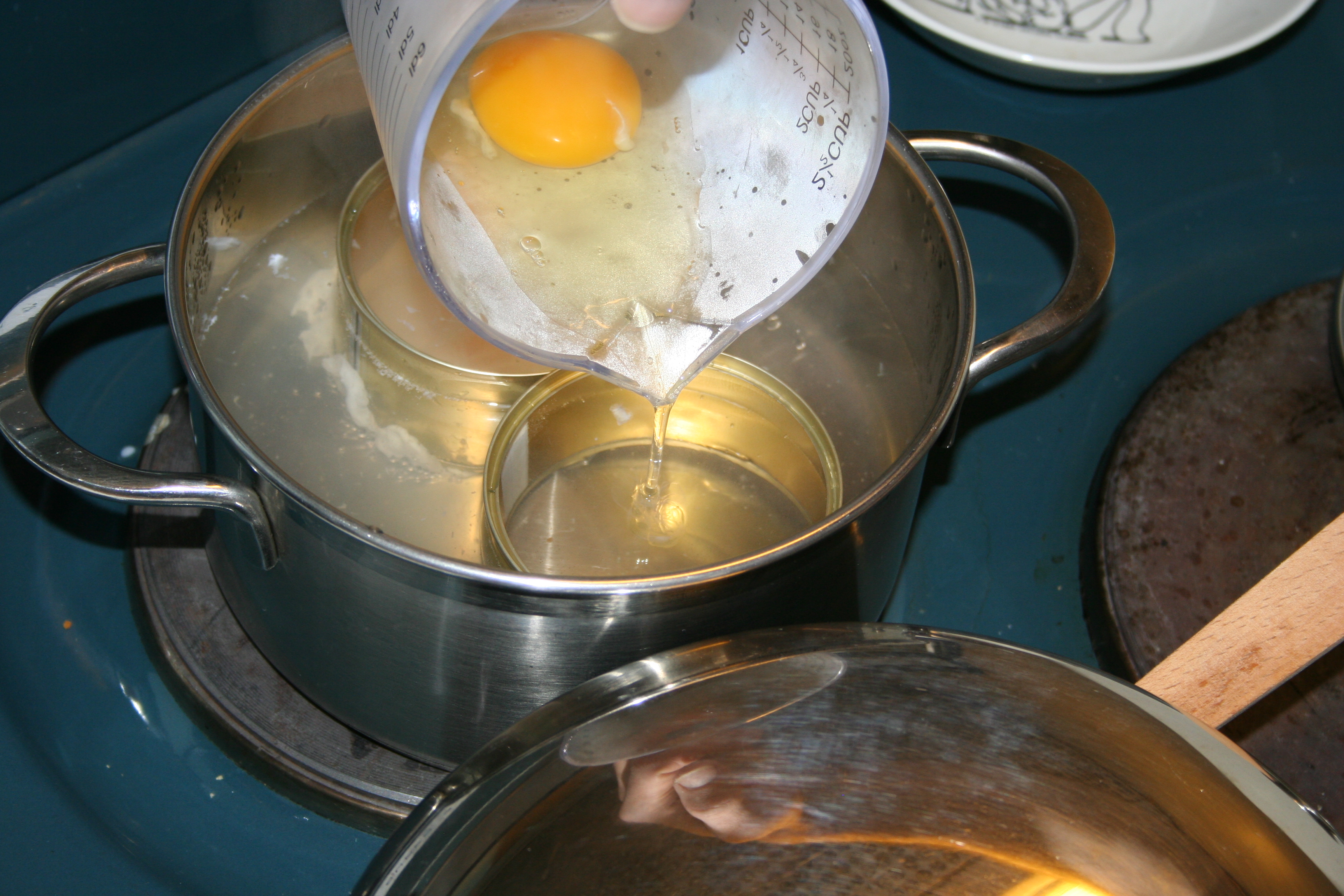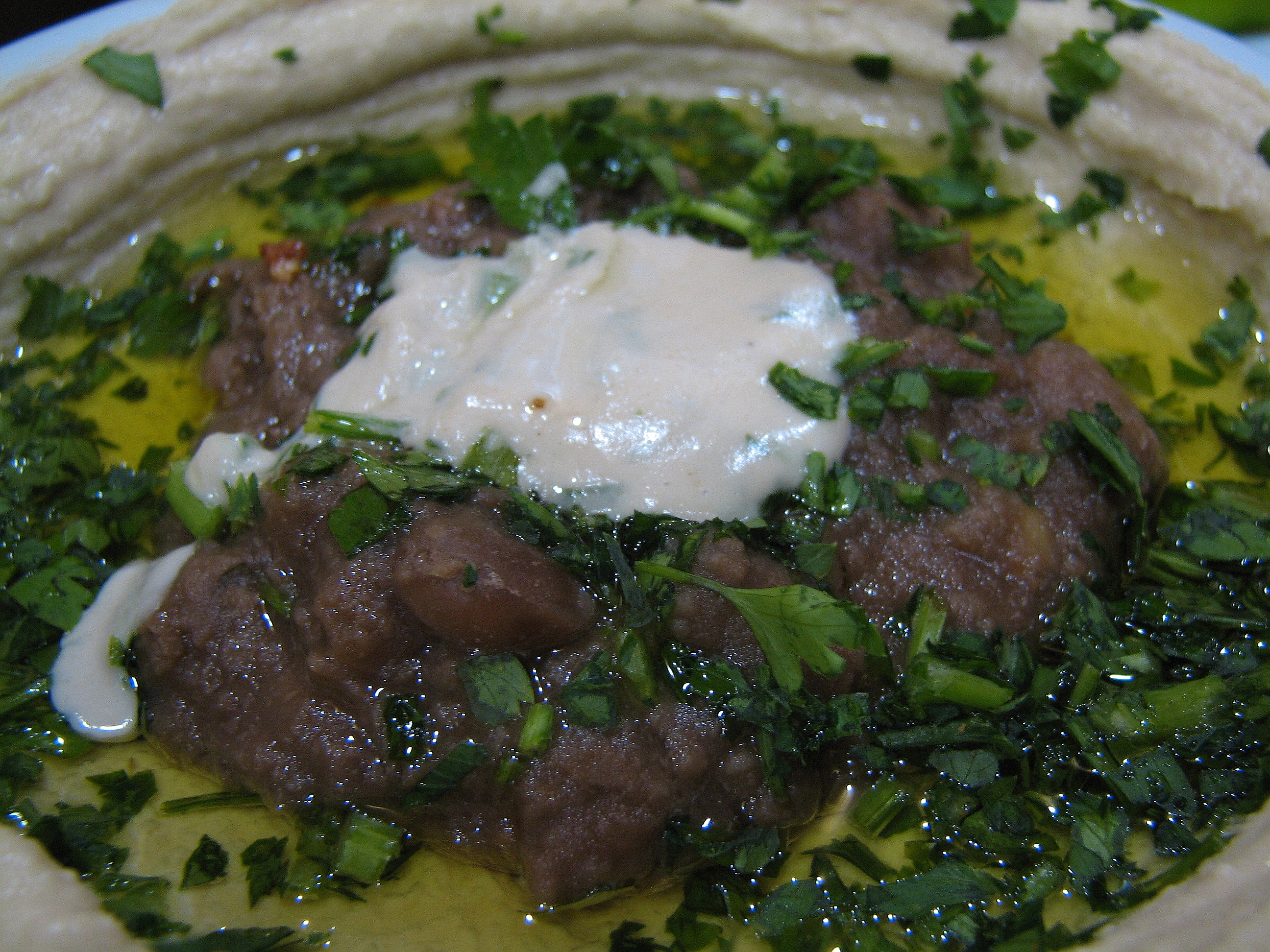|
Haminados
Haminados, also known as chaminados, or braised eggs, is a traditional Sephardi Jewish dish, popular in Israel, and commonly served as an ingredient or accompaniment to a number of dishes. Haminados are an important element of Israeli cuisine, and are commonly prepared on their own or as part of the Sephardi and Mizrahi Jewish Shabbat stew chamin. Overview Haminados typically consists of whole eggs in the shell, which are placed on top of a hamin (a Shabbat stew) in the stewing pot. The eggs are braised over many hours, often overnight and turn brown in the course of all-night cooking. The brown eggs, called ''haminados'' (''güevos haminadavos'' in Ladino, ''huevos haminados'' in Spanish), are shelled before serving and placed on top of the other cooked ingredients. In the Tunisian version, the brown eggs are cooked separately in a metal pot on the all-night stove with water and tea leaves (similar to tea eggs). ''Haminados'' can be cooked in this way even if no hamin is pr ... [...More Info...] [...Related Items...] OR: [Wikipedia] [Google] [Baidu] |
Hamin
Cholent and other Sabbath stews ( yi, טשאָלנט, tsholnt ''or'' tshulnt) are traditional Jewish stews. It is usually simmered overnight for 10–12 hours or more, and eaten for lunch on Shabbat (the Sabbath). Shabbat stews were developed over the centuries to conform with Jewish laws that prohibit cooking on the Sabbath. The pot is brought to a boil on Friday before the Sabbath begins, and sometimes kept on a blech or hotplate, or left in a slow oven or electric slow cooker, until the following day. Cholent originated as a barley porridge in ancient Judea called "harisa" or "horisa",Gil Marks, Encyclopedia of Jewish Foods, 656 (Hoboken, N.J.: John Wiley & Sons, 2010), 40. possibly as far back as the Second Temple period, and over the centuries various Jewish diaspora communities created their own variations of the dish based on local food resources and neighborhood influence. There are many variations of the dish, which is standard in both the Ashkenazi and Sephardi kit ... [...More Info...] [...Related Items...] OR: [Wikipedia] [Google] [Baidu] |
Sabich
Sabich or sabih ( he, סביח ) is a sandwich of pita or laffa bread stuffed with fried eggplants, hard boiled eggs, chopped salad, parsley, Amba (condiment), amba and tahini sauce. It is an Iraqi Jews, Iraqi Jewish dish that has become a staple of Israeli cuisine, as a result of Iraqi Jewish immigration to Israel. Its ingredients are based on a traditional quick breakfast of Iraqi Jews and is traditionally made with laffa, which is nicknamed Iraqi pita. Sabich is sold in many businesses throughout Israel. Etymology There are several theories on the origin of the name sabich. Many credit the name to the first name of Sabich Tsvi Halabi, a Jews, Jewish man born in Iraq who operated a small restaurant in Ramat Gan, and who is credited for originally serving the sandwich. Another theory is that sabich is an acronym of the Hebrew words "Salat, Beitsa, Yoter Ḥatsil" , meaning "salad, egg, more eggplant". This is probably a humorous interpretation and hence a backronym. History T ... [...More Info...] [...Related Items...] OR: [Wikipedia] [Google] [Baidu] |
Israeli Cuisine
Israeli cuisine ( he, המטבח הישראלי ) comprises both local dishes and dishes brought to Israel by Jews from the Diaspora. Since before the establishment of the State of Israel in 1948, and particularly since the late 1970s, an Israeli Jewish fusion cuisine has developed.Gold, Rozann''A Region's Tastes Commingle in Israel'' (July 20, 1994) in ''The New York Times'' Retrieved 2010–02–14 Israeli cuisine has adopted, and continues to adapt, elements of various styles of Arab cuisine and diaspora Jewish cuisine, particularly the Mizrahi, Sephardic and Ashkenazi styles of cooking. It incorporates many foods traditionally included in other Middle Eastern and Mediterranean cuisines, so that spices like '' za'atar'' and foods such as ''falafel'', ''hummus'', ''msabbha'', '' shakshouka'' and '' couscous'' are now widely popular in Israel.Gur, ''The Book of New Israeli Food'', pg. 11 Other influences on the cuisine are the availability of foods common to the Mediterranean ... [...More Info...] [...Related Items...] OR: [Wikipedia] [Google] [Baidu] |
Hamin
Cholent and other Sabbath stews ( yi, טשאָלנט, tsholnt ''or'' tshulnt) are traditional Jewish stews. It is usually simmered overnight for 10–12 hours or more, and eaten for lunch on Shabbat (the Sabbath). Shabbat stews were developed over the centuries to conform with Jewish laws that prohibit cooking on the Sabbath. The pot is brought to a boil on Friday before the Sabbath begins, and sometimes kept on a blech or hotplate, or left in a slow oven or electric slow cooker, until the following day. Cholent originated as a barley porridge in ancient Judea called "harisa" or "horisa",Gil Marks, Encyclopedia of Jewish Foods, 656 (Hoboken, N.J.: John Wiley & Sons, 2010), 40. possibly as far back as the Second Temple period, and over the centuries various Jewish diaspora communities created their own variations of the dish based on local food resources and neighborhood influence. There are many variations of the dish, which is standard in both the Ashkenazi and Sephardi kit ... [...More Info...] [...Related Items...] OR: [Wikipedia] [Google] [Baidu] |
Chamin
Cholent and other Sabbath stews ( yi, טשאָלנט, tsholnt ''or'' tshulnt) are traditional Jewish stews. It is usually simmered overnight for 10–12 hours or more, and eaten for lunch on Shabbat (the Sabbath). Shabbat stews were developed over the centuries to conform with Jewish laws that prohibit cooking on the Sabbath. The pot is brought to a boil on Friday before the Sabbath begins, and sometimes kept on a blech or hotplate, or left in a slow oven or electric slow cooker, until the following day. Cholent originated as a barley porridge in ancient Judea called "harisa" or "horisa",Gil Marks, Encyclopedia of Jewish Foods, 656 (Hoboken, N.J.: John Wiley & Sons, 2010), 40. possibly as far back as the Second Temple period, and over the centuries various Jewish diaspora communities created their own variations of the dish based on local food resources and neighborhood influence. There are many variations of the dish, which is standard in both the Ashkenazi and Sephardi kitch ... [...More Info...] [...Related Items...] OR: [Wikipedia] [Google] [Baidu] |
Sabich
Sabich or sabih ( he, סביח ) is a sandwich of pita or laffa bread stuffed with fried eggplants, hard boiled eggs, chopped salad, parsley, Amba (condiment), amba and tahini sauce. It is an Iraqi Jews, Iraqi Jewish dish that has become a staple of Israeli cuisine, as a result of Iraqi Jewish immigration to Israel. Its ingredients are based on a traditional quick breakfast of Iraqi Jews and is traditionally made with laffa, which is nicknamed Iraqi pita. Sabich is sold in many businesses throughout Israel. Etymology There are several theories on the origin of the name sabich. Many credit the name to the first name of Sabich Tsvi Halabi, a Jews, Jewish man born in Iraq who operated a small restaurant in Ramat Gan, and who is credited for originally serving the sandwich. Another theory is that sabich is an acronym of the Hebrew words "Salat, Beitsa, Yoter Ḥatsil" , meaning "salad, egg, more eggplant". This is probably a humorous interpretation and hence a backronym. History T ... [...More Info...] [...Related Items...] OR: [Wikipedia] [Google] [Baidu] |
Hummus
Hummus (, ; ar, حُمُّص, 'chickpeas'; full Arabic name: ''ḥummuṣ bi-ṭ-ṭaḥīna'' ar, حمص بالطحينة, 'chickpeas with tahini'), also spelled hommus or houmous, is a Middle Eastern dip, spread, or savory dish made from cooked, mashed chickpeas blended with tahini, lemon juice, and garlic. The standard garnish in the Middle East includes olive oil, a few whole chickpeas, parsley, and paprika. In Middle Eastern cuisine, it is usually eaten as a dip, with pita bread. In the West, it is now produced industrially, and is often served as a snack or appetizer with crackers. Etymology and spelling The word ''hummus'' comes from ar, حُمُّص, ḥummuṣ 'chickpeas'. The full name of the prepared spread in Arabic is 'chickpeas with tahini'. The colloquial Arabic word is a variant of the Arabic or which may be derived from the Aramaic language (), corresponding to the Syriac word for chickpeas: . The word entered the English language around the ... [...More Info...] [...Related Items...] OR: [Wikipedia] [Google] [Baidu] |
Poached Egg
A poached egg is an egg that has been cooked, outside the shell, by poaching (or sometimes steaming), as opposed to simmering or boiling. This method of preparation can yield more delicately cooked eggs than cooking at higher temperatures such as with boiling water. Preparation The egg is cracked into a cup or bowl of any size, and then gently slid into a pan of water at approximately 75° C (167 °F) and cooked until the egg white has mostly solidified, but the yolk remains soft. The "perfect" poached egg has a runny yolk, with a hardening crust and no raw white remaining. In countries that mandate universal salmonella vaccination for hens, eating eggs with a runny yolk is deemed safe for consumption. Broken into water at the poaching temperature, the white will cling to the yolk, resulting in cooked egg white and runny yolk. Any given chicken egg contains some egg white that is prone to dispersing into the poaching liquid and cooking into an undesirable foam. To prevent this, ... [...More Info...] [...Related Items...] OR: [Wikipedia] [Google] [Baidu] |
Hardboiled Egg
Boiled eggs are eggs, typically from a chicken, cooked with their shells unbroken, usually by immersion in boiling water. Hard-boiled eggs are cooked so that the egg white and egg yolk both solidify, while soft-boiled eggs may leave the yolk, and sometimes the white, at least partially liquid and raw. Boiled eggs are a popular breakfast food around the world. Besides a boiling water immersion, there are a few different methods to make boiled eggs. Eggs can also be cooked below the boiling temperature, i.e. coddling, or they can be steamed. The egg timer was named for commonly being used to time the boiling of eggs. Variations There are variations both in degree of cooking and in the method of how eggs are boiled, and a variety of kitchen gadgets for eggs exist. These variations include: ;Piercing: Some pierce the shell beforehand with an egg piercer to prevent cracking. Ekelund ''et al.'' in ''Why eggs should not be pierced'' claimed that pricking caused egg white proteins ... [...More Info...] [...Related Items...] OR: [Wikipedia] [Google] [Baidu] |
Tahini
Tahini () or tahina (, ) is a Middle Eastern condiment made from toasted ground hulled sesame. It is served by itself (as a dip) or as a major ingredient in hummus, baba ghanoush, and halva. Tahini is used in the cuisines of the Levant and Eastern Mediterranean, the South Caucasus, as well as parts of North Africa. Sesame paste (though not called tahini) is also used in some East Asian cuisines. Etymology ''Tahini'' is of Arabic origin and comes from a colloquial Levantine Arabic pronunciation of (), or more accurately (), whence also English ''tahina'' and Hebrew ''t'china'' . It is derived from the root , which as a verb means "to grind", and also produces the word , "flour" in some dialects. The word ''tahini'' appeared in English by the late 1930s.Mariposa, ''Hollywood Glamour Cook Book'', 1940, p. 101. ''Tahini'' is a loanword from modern Greek ''tachíni'' () which was originally adopted from the Ottoman Turkish ''"tahin"'' . In Turkish and also in Ital ... [...More Info...] [...Related Items...] OR: [Wikipedia] [Google] [Baidu] |
Chickpea
The chickpea or chick pea (''Cicer arietinum'') is an annual legume of the family Fabaceae, subfamily Faboideae. Its different types are variously known as gram" or Bengal gram, garbanzo or garbanzo bean, or Egyptian pea. Chickpea seeds are high in protein. It is one of the earliest cultivated legumes, and 9500-year-old remains have been found in the Middle East. The chickpea is a key ingredient in Mediterranean and Middle Eastern cuisines, used in hummus, and, when ground into flour, falafel. It also is important in Indian cuisine, used in salads, soups and stews, and curry, in chana masala, and in other meal products like channa. In 2019, India was responsible for 70% of global chickpea production. Etymology The name "chickpea," earlier "chiche pease," is modelled on Middle French ', where ''chiche'' comes from Latin '. "Chich" was used by itself in English from the 14th to the 18th centuries.''Oxford English Dictionary'', 3rd edition, December 201''s.v.''/ref> The word ' ... [...More Info...] [...Related Items...] OR: [Wikipedia] [Google] [Baidu] |
Ful Medames
Ful medames ( ar, فول مدمس, ' ; other spellings include ''ful mudammas'' and '' foule mudammes''), or simply fūl, is a stew of cooked fava beans served with olive oil, cumin, and optionally with chopped parsley, garlic, onion, lemon juice, chili pepper, and other vegetable, herb, and spice ingredients. Ful medames is traditionally made in and served out of a large metal jug. It is notably a staple food in Egypt and is considered a national dish, especially in the northern cities of Cairo and Gizah. Fava beans can sometimes be also found in other cuisines in the Middle East, and Africa, though cooked differently. History Some writers have suggested that ful medames dated all the way back to Ancient Egypt. Some evidence of the use of ful is a cache of 2,600 dried fava beans unearthed at a late Neolithic site on the outskirts of Nazareth. This dish is mentioned in the Jerusalem Talmud, indicating that it was used in Horn of African and Middle Eastern countries since the fo ... [...More Info...] [...Related Items...] OR: [Wikipedia] [Google] [Baidu] |









